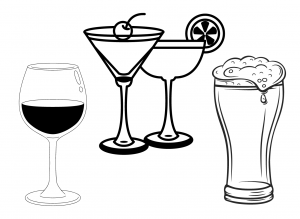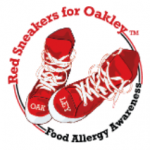With St. Patrick’s Day and Spring Break getaways ahead you’ll want to share this article with your college kids with food allergies. A quick read of this post from Red Sneakers for Oakley can help them stay safe. We’re hoping it’ll open their eyes to (avoidable) allergen risks in drinking that could derail the fun and simple steps they can take to protect themselves.
St. Patrick’s Day is right around the corner and it ‘tis the season for Spring Break getaways for college students — both fun times, more often than not, involving drinking with friends.
If you manage food allergies, it’s important to know exactly what you’re drinking and to drink mindfully when out and about having fun.
Here are some tips that can help you stay safe navigating the drinking scene, whether it’s your local Irish pub or sun-warmed sands someplace south of northern rain, ice, and snow.
Before You Go, Educate Yourself
- Know your reaction triggers and research allergy-friendly alcoholic beverages that you’d like to drink BEFORE YOU GO.
- Go online to research ingredients for beverages you’re interested in drinking, or better yet, call the manufacturers directly. Gather as much information as you can about the alcoholic beverages and ingredients that could trigger an allergic reaction.
- Learn the differences between the brands so you know which beverages/brands are your safest options.
- Take a test run with your beverage picks BEFORE YOU GO. Try them out at home before prime time drinking starts away from home.
Communicate Clearly
- Ensure your bartenders know about your allergies.
- Tell them they must use clean glasses and utensils (like shakers, blender pitchers, strainers, spoons, knives) for your order to avoid cross-contact.
- Don’t be shy about asking to read ingredient lists or labels on alcoholic beverages. Alcohol may contain unexpected ingredients like ‘botanicals’ (made from proprietary combinations of herbs, fruits, seeds, bark, roots, and spices) that could cause a reaction. Be informed before you drink.
Be Cautious With Mixed Drinks
- Try not to complicate the situation by drinking mixed cocktails. Don’t let curiosity get the best of you. Cocktails often involve multiple ingredients and can be risky. For example, did you know? The light and airy froth on some cocktails can be made from egg whites, or even aquafaba, the liquid from canned chickpeas.
- Garnishes, such as citrus slices, celery sticks, or maraschino cherries can be troublesome, too. Beyond being potential allergens in their own right, it’s possible they might have been handled with utensils that could have touched your allergens.
- It’s safer to stick to single-ingredient beverages such as wine or pure spirits. Keep it very simple.
Have A Backup Plan
- ALWAYS carry your epinephrine auto-injectors and antihistamines on you.
- Surround yourself with trustworthy friends. Make sure they’re familiar with your emergency plan and know how to administer your epinephrine auto-injector (and any other medication you need) for an allergy emergency.
- If you feel uncomfortable or uncertain about the drinks being served, do not be embarrassed to decline a drink, or order a soft drink instead, or even leave the situation. It’s better to leave than to put your safety at risk.
- Too much alcohol can cloud your decision making on whether/when to use your epinephrine or antihistamine. Please drink responsibly and mindfully.
A Word About Co-Factors**
- For some people, certain factors can make a food-allergic reaction worse, or can trigger a severe reaction after a slight allergen exposure that normally would not have caused one. These factors are called co-factors.
- Co-factors include exercise, alcohol and taking non-steroidal anti-inflammatory drugs (or NSAIDs, including aspirin and ibuprofen like Advil or Motrin.) Even dehydration and infection could be co-factors according to a review published in the National Library of Medicine to educate clinicians on developments in the role of cofactors.
- Be mindful of these co-factors and their potential impact on your reactivity when you socialize.
Allergens Can Hide In Alcoholic Beverages—Sip With Caution**
Please note that this list provides examples but they’re not all-inclusive. Do your research so you know before you go what you can drink safely and will like!
Egg Allergy
Certain frothy or creamy cocktails may contain egg whites (e.g., Amaretto Sour, Negroni Sour.) And, sometimes the egg white flies as bartenders crack eggs to make a cocktail’s frothy finish, landing on glassware and utensils. Study what goes on behind the bar to identify allergen risks.
Dairy Allergy
Beverages like lattes, milkshakes, and certain smoothies and cocktails may contain cow’s milk. Even liqueurs can contain milk (like Baileys Irish Cream.) Tread cautiously.
Fish & Shellfish Allergies
Some Bloody Mary mixes contain ingredients like Worcestershire sauce which may contain anchovies. Though perhaps less common, clam juice and oysters can be used in cocktails from Bloody Mary’s to Martinis. Be aware that these ingredients may be present behind the bar and could pose a cross contact risk.
Nut Allergy
Nuts are ingredients in some craft beers, some distilled spirits (like Bombay Sapphire and Beefeater gin), and liqueurs (like Frangelico, Galliano, Nocello.) Researching ingredients is your safeguard, so get the facts and know before you go where tree nuts lurk.
Almond, cashew, hazelnut, and other nut milks are popular alternatives to dairy and are frequently used as substitutes. They can easily be mistaken, one for another, by a frazzled bartender or barista.
Bowls of mixed nuts are sometimes offered at bars. Be conscious of your surroundings and aware that hands with nut residues may have touched the bar, bar stools, and tabletops.
Peanut Allergy
Peanuts are found in some craft beers, liqueurs, and distilled spirits. Did you know, for example, that peanut butter flavored whiskeys and rums are a thing? Even peanut butter vodka?
Be aware if peanuts are being served at the bar — the bar, bar stools, and table tops may have peanut residue on them. Be observant. Be careful.
Sulfite Sensitivity
Some people are sensitive to sulfites which are commonly found in wine. Sulfites are disclosed on wine labels, making your research to find sulfite-free wines easier. Choose sulfite-free wines when you can, or a different beverage if sulfite-free wine isn’t an option.
Wheat Allergy or Celiac Disease
Beers and malted beverages (sometimes even ciders) are often made with gluten-containing grains. Gluten-free beers can be tasty and satisfying and they’re becoming more widely available. Check with your server to see if they offer gluten-free beer options. Choose with caution.
Other Allergies & Sensitivities
Latex Fruit Syndrome
Latex fruit syndrome is a cross-reactivity between latex and certain fruits (like banana, avocado, kiwi). If you have a latex allergy you might experience symptoms after consuming these fruits, so be cautious with fruit juices made from these fruits, as well.
Artificial Additives
If you’re sensitive or allergic to Artificial Additives, check ingredients labels for artificial colors, flavors, and sweeteners.
A Note re: Wine — As in Helpful to Know**
Organic and inorganic substances are added to some wines to remove particles that affect the wine’s appearance and taste. They’re known as fining agents. Organic fining agents can include: Egg Albumen (from egg whites,) Casein (from Milk), Isinglass (from the air/swim bladders of certain kinds of fish,) Chitin (a fiber from crustacean shells,) and Gelatin (derived from animal parts.) Fining agents are added during the winemaking process and are technically supposed to be 100% removed from the finished product, though minute traces could remain. The types of fining agents winemakers use to fine their wines are not disclosed on wine labels in the U.S.

Have Fun With Eyes Wide Open!
Red Sneakers for Oakley seeks to equip you with the best possible data from published sources that can help keep you safe. Thank you @redsneakersforoakley for summarizing this important information and permitting us to share it with the Allergy Force community.
Put on your red sneakers
In memory of Oakley
In support of food allergy awareness

In November 2016, the Debbs Family tragically lost their 11-year-old son, Oakley, to a fatal anaphylactic reaction resulting from a nut allergy. Shortly after Oakley’s death, the family decided to publicly share Oakley’s story to help raise awareness about the dangers of food allergies. They saw a need for awareness and founded the non-profit organization Red Sneakers for Oakley in memory of their son. Oakley wore red sneakers in the multiple sports he played so it was only natural that the family looked to Oakley’s favorite shoes as a powerful symbol to represent the severity of food allergies. Please support @redsneakersforoakley. |
|
… |
|
Image: Elevate on Pexels
**Sources & Resources
Co-factors
- ‘Ask the Allergist’ article on Co-factors from Allergic Living
- Review of co-factors published in the National Library of Medicine by Clinical and Experimental Pediatrics
Hidden Allergens
- Helpful article with background on allergens hiding in alcohol from Erudus.com
- Summary of allergens found in wine, including fining agents plus others
Fining
- Brief explanation of fining from Wine.com
Other Resources
- This downloadable handout from FAACT on “Navigating Alcohol at a Party” could be a helpful conversation starter.


